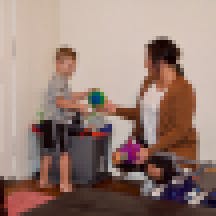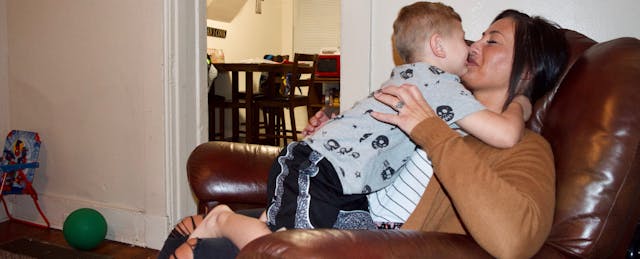HAMILTON, Ohio — In the living room of his mother’s apartment, a threadbare two-story unit next to the train tracks, Ryder pulls out bulky plastic toys from a bin and wonders aloud about how they work, smiling toothily, mumbling along to “Baby Shark” and occasionally popping another fruit-flavored gummy into his mouth.
Although he maneuvers from one activity to the next with the energy and ease of a typical tyke, Ryder, at age 4, has already been exposed to more instability and anguish than most people will experience in a lifetime.
Born into a family struggling with opioid addiction in early 2016, Ryder joined his mother at two separate residential treatment centers before the age of 2, and later lived with her in a homeless shelter for more than 100 days. He witnessed heated, sometimes violent, arguments among adults close to him. By age 3, he and his newborn brother, River, had been separated from their parents and placed in the custody of family friends.
Ryder is among a small but growing number of children who, like addicts themselves, require rehabilitation. Many encounter unspeakable trauma and abuse before they’ve learned to walk or read. The events and experiences they’ve lived through tend to manifest in clinical trauma symptoms—such as anxiety, aggression and dissociation—and through behavioral and cognitive delays.
Alexa Bihner, Ryder’s mother, first noticed these symptoms in her son in late 2018. At the time, she was in outpatient treatment for substance abuse and permitted to see her children for a few hours each week. During these visits, she recalls, Ryder started to exhibit severe attachment and behavioral issues, characterized by “screaming, yelling, flipping tables, kicking toys, a little bit of harm to [his infant brother], but more so just anger in general.” She attributes his challenges to the “chaotic environment” she’d raised him in.
But in what may be the luckiest break of his short life, Ryder lives in a county with a specialized program created to help him process the trauma he has endured and reduce the symptoms that come with it. Out of a destructive crisis that has reshaped families and entire communities—especially in Ohio, with the second-highest rate of opioid overdose deaths in the country—Ryder and his mother found a rare bright spot, a preschool led by a group of educators and health professionals dedicated to repairing some of the damage inflicted on the youngest victims of the opioid epidemic.

For Ryder and other children who have faced immeasurable hardship, the program, by and large, appears to be working. Data shows that their trauma symptoms, including anxiety, anger and post-traumatic stress disorder (PTSD), are reduced by nearly half over the course of one school year. Children in the program also develop resilience, self-regulation and other skills to better manage stress and mitigate future risk.
Parents and staff, too, report marked improvements in the kids.
“He’s changed a lot,” Bihner says of her son. “He’s a lot better at showing his emotions, identifying how he’s feeling and expressing that.”

BIHNER REGAINED FULL CUSTODY of Ryder and River, her now-1-year-old, in January 2019. After learning that Ryder’s experiences—and the outbursts they provoked in him—signaled that he needed intervention, she requested that her caseworker from the local children’s services agency refer him to Butler County’s therapeutic interagency preschool (TIP) program, designed for children who have experienced severe childhood trauma. By April 2019, Ryder was enrolled.
Leveraging one-on-one mental health counseling, low teacher-to-child ratios, frequent home visits, and a curriculum focused on social and emotional development, the TIP program works year-round with 3-, 4- and 5-year-olds who have been abused, neglected or otherwise mistreated and face behavioral and developmental challenges as a result.
TIP has been around since 1989, but in the last decade, as the rate of opioid-related deaths in Ohio has increased more than 300 percent, the program has seen a spike in demand. There is a long waitlist of children in need of the crucial services it provides.
“If we don’t catch it early, it’s harder to rebuild,” explains Ashley Dobrozsi-Ferguson, director of the TIP program, which is based in Hamilton, a small city in southwest Ohio with about 60,000 residents. “The older the kids get, the smaller the doorway is to learning. But right now, it’s a gate we can push through.”
TIP was founded by two women at Cincinnati Children’s Hospital to treat young victims of abuse and neglect and is funded by Head Start, a federal program that provides preschool to children from low-income families. TIP receives additional support from the Ohio Department of Job and Family Services and a local mental health agency. The program is unique to Ohio, but in communities all over the country that have been ravaged by the opioid crisis, educators and health professionals have mobilized to establish their own homegrown programs to support children impacted by the drug epidemic.
There is also a national effort seeking to research—and fund—promising models and solutions.
The National Head Start Association, a nonprofit advocacy and professional support organization for Head Start, convened an Opioid Working Group in spring 2018 after hearing from educators that children in areas hardest-hit by the opioid epidemic were exhibiting an unusually high frequency and intensity of challenging behaviors.
A few months later, the group issued a report that identified 14 states with programs that are addressing this issue and examined the common elements that led to their success: mental health services, a trauma-informed approach, low teacher-to-child ratios and data analysis.
As it happens, all four factors are hallmarks of Butler County’s TIP program, which serves 36 children across three classrooms, dubbed “A,” “B” and “C.”

INSIDE CLASSROOM B, children are just starting to arrive for the day. They file in, one after the other, passing a large cinder block wall covered with homemade artwork and photos of themselves playing at school, often with each other or their teachers.

Above the wall, “We are a family” is emblazoned in large letters. This is important—and intentional—says Dobrozsi-Ferguson, the TIP director. About 70 percent of the children in TIP are in foster care or kinship care, meaning they live with a family friend or family member other than their parents. Many have moved homes multiple times. So instead of including photos of their biological or foster families, which can be painful or confusing for the kids, the teachers emphasize the class as a family.
Children in TIP attend half-day classes from Monday through Thursday. Each of the three classrooms can accommodate 12 TIP students and two “traditional” Head Start children. Given the additional challenges and needs of this population, each TIP class employs three professionals—a lead teacher and two assistants—to care for the 14 children, compared to the two-to-17 ratio that is required for Head Start classrooms nationwide.
Shortly after serving breakfast, the teachers pass out small plastic bowls filled with milk and lead the children through a science experiment that involves stirring food coloring in with Q-tips. The activity is punctuated by high-pitched, electronic bells on the door, which chime each time someone enters the room. It’s a nuisance to the staff, but necessary: On occasion, parents who have lost custody have burst into the TIP building to get to their child, Dobrozsi-Ferguson explains.

While the kids mix and play, a polished-looking woman enters the classroom, approaches one of the children, then leads him out. This is Jennifer Minnick, the licensed professional counselor who is on staff to help the kids work through their trauma during individual counseling sessions.
The rest of the children participate in a lesson on zoo animals. Andrea Jackson, the lead teacher in Classroom B, encourages them to come up, one at a time, and draw a picture of their favorite zoo animal on the board.

Most of the images are indecipherable, but that’s not the point. By asking them to name an animal, draw it and imitate the sound it makes, Jackson has given the kids something they are often deprived of: agency and a sense of control.
Staff at TIP know this is critical, and it applies to matters both small and large, whether it’s choosing to oink like a pig or deciding whether to see their biological dad next weekend.
“To not have any control or say in your life is horrible,” Minnick explains. “People don’t realize that little children still need to have some control.”
Bihner learned this during a home visit from TIP staff, who use the opportunity to share insights, strategies and observations they’ve made about a child. As a result, Ryder and Bihner went shopping so he could pick out some new clothes for himself. (His favorite is a green Under Armour shirt.)
Ryder is enrolled in TIP Classroom A, which is led by teacher Montessa Morgan. During the mid-morning “circle time,” each child finds a separate cushion and takes a seat. The cushions—which are just pet beds from Amazon, Dobrozsi-Ferguson admits with a smirk—help reinforce the concept of boundaries and personal space to the kids. Their goal is to stay on their cushion, and not to touch anyone who is outside of it. (Minnick, the counselor, uses hula hoops in her office for a similar purpose.)

Morgan reads the children a book, “Honey … Honey … Lion!” and then guides them through a set of breathing techniques from Conscious Discipline, an approach to social-emotional learning that TIP has been using with the children since around 2009. Conscious Discipline also provides in-person training and materials to help TIP teachers understand and implement trauma-informed care.

THE CHILDREN IN TIP are curious, playful and still learning how to follow directions and manage their impulses, just like children in any other preschool classroom. But the outbursts are more frequent, from Rice Krispies flung across the room to screaming fits that can’t be quelled. And many of the children are, on average, about 12 to 18 months behind developmentally, though the delays vary based on each child’s history, Dobrozsi-Ferguson says.
The delays are correlated to the trauma TIP students have faced, which the program measures using a series of 10 questions that gauge a child’s exposure to Adverse Childhood Experiences (ACEs). Based on a study published in the 1990s by the Centers for Disease Control and Prevention (CDC) and Kaiser Permanente, the ACEs questions evaluate the extent of a person’s trauma and project their future health risks.
When a child enrolls in TIP, staff talk with the caseworker, foster parents and sometimes the biological family to understand each child’s trauma history—including abuse, neglect and household dysfunction such as parental incarceration, mental illness and death. The staff then use that information to tally the child’s ACEs score.
On average, the children in TIP this year have experienced seven types of ACEs, out of a possible 10. The CDC estimates that 36 percent of Americans have never experienced an ACE, 26 percent have experienced just one and only 12.5 percent have had four or more ACEs. That puts the children in TIP in a narrow, fateful category.
Of the 44 children who have come through or are currently enrolled in the program this school year, almost 90 percent have been exposed to substance abuse—heroin is most prevalent, followed by methamphetamine. Nearly 86 percent have experienced emotional and physical neglect, 84 percent have been around mental illness in the home and more than half have witnessed domestic violence.

For each point toward their ACEs score, a child’s chances of a full and healthy life slip further. Research indicates that children with higher ACEs will suffer more chronic health issues, mental illnesses and substance abuse. ACEs are also linked to toxic stress, violence, poverty and incarceration.

Less than 10 years ago, the average ACEs score among TIP students was four. Then the opioid crisis began to overwhelm Ohio, and that number has been climbing ever since, says Suzanne Prescott, the early childhood programs director at Butler County Educational Service Center, which oversees Head Start and TIP. “It brings tears to my eyes every time I say it,” Prescott says, her voice catching. She understands all too well that behind each number is a story that will shape each child’s life indefinitely.
Like the brothers who are in TIP together. Both were physically abused, staff say, but the older boy, nearly 5 now, bore the brunt of it. He says few words and erupts with piercing screams throughout the day. His younger brother has already eclipsed him in speech and cognitive and physical development. For the older boy, being able to sit and play with Play-Doh for several minutes at a time this year is a vast improvement, his teachers say.
There’s a girl whose stepmom smacked her in the mouth for having an accident last fall. And a child whose mother committed suicide after learning she would not regain custody of her children. There’s a boy who has been moved around so many times that, after no one came to pick him up from school one day, a staff member—drawing a blank—had to ask another, “Who has custody?”

DEVELOPING INDIVIDUAL TREATMENT PLANS is a collaborative effort between TIP teachers and health professionals, who carefully review each child’s unique case history, traumatic experiences, challenging behaviors and any mental health diagnoses they may have, which are made by Minnick.
The teachers measure children’s progress three times per year using the Devereux Early Childhood Assessment (DECA), a 38-question evaluation of children’s social and emotional skills. The scores inform the strategies educators use to help each child build protective factors in areas such as initiative, self-control and relationships.
“You can never take away the trauma that’s happened to kids,” Prescott explains, “but you can build up protective factors for the future.”
Sometimes Minnick, the counselor, will go into the classrooms and use situations that arise organically to work with kids on social skills they’ve been learning, such as playing cooperatively, anger management and impulse control.
But during one-on-one sessions, which the children refer to as “talk work,” Minnick focuses on emotion regulation. This is when the kids share their experiences, if they’re ready, and build skills and techniques to overcome them.
Minnick’s office, where the talk work takes place, is a kid’s kingdom, bathed in cool colors and stocked full of tools that will help children identify emotions they may not yet have a name for. There’s a “feelings finder” with corresponding emotive magnets, feelings flashcards and stuffed dolls called Feeling Buddies.

Some children respond to sensory tools, such as sand trays and colorful liquid floor mats. Minnick also uses “play therapy,” aided by props like puppets and a doll house, to provide an outlet for the children to share what they may have seen or experienced at home.
“A lot of times they end up acting out things that they’ve lived through, things that they’re stuck in,” Minnick says of the play therapy. “So my job as a therapist, then, would be to help them come through that trauma and talk about the ‘What ifs?’ and ‘How could Mommy or Daddy have done that differently?’ and ‘What are all the wonderful things you were able to do to keep yourself safe?’ You have to get them through it so they’re not stuck in it anymore and they can let it go.”

MINNICK IS A RARE EXCEPTION among the TIP staff, having been with the program for over 10 years. The turnover rate in TIP is high, with most classroom teachers only lasting about two or three years.
Nearly everyone on staff notes this as a major obstacle for the program. “I think they just get burnt out,” says Morgan, who has been the lead teacher in Classroom A since June 2019. “It’s a lot each day."
While early childhood educators in general face endless challenges working with young children, those challenges are compounded for TIP teachers, many of whom experienced childhood trauma themselves and have friends and family members suffering from opioid addiction.
Morgan says she struggled to hear some of the kids’ personal histories when she started the job, having grown up in foster care herself. “It tore me down,” she says. “It brought everything back for me.”
The other lead teacher, Andrea Jackson, was hired in summer 2019, after 10 years of working as a director of a day care center and a lead preschool teacher. Unlike Morgan, she teaches “double TIP,” or one class in the morning and another in the afternoon.
“At first it was a serious culture shock,” she says, describing 3- and 4-year-olds standing on shelves, throwing toys, using profanities and making passing comments about selling and using drugs. “But now it’s more of, ‘How can I help you understand that that’s not a way of life that you should be comfortable with?’”
Jackson says many kids get excited when the teachers clean their ears out or brush their teeth. Some will hoard food during meal time or ask, panic-stricken, when they will get their next snack. During exchanges such as these, when she realizes just how insecure their lives are outside of school, Jackson says she struggles to hold herself together.

The first time she faltered was about two months into the school year, when one of Jackson’s students was removed from her home and placed in foster care. It was a Thursday, the last day Jackson would see the children that week. For three days, she didn’t know where the girl would be placed, or if she’d be coming back to her classroom.
“That was a really rough weekend for me, and I was not able to turn it off, because all I could think about was, ‘I hope she’s got breakfast, lunch and dinner. I hope she has a warm bed. I hope someone’s being nice to her,’” Jackson recalls. “I don’t think I’ve ever cried so much.”
After a weekend in agony, the staff learned the girl had found a home in Butler County and would be returning to class that Monday, not even missing a day of school.
“She came running in, and she gave us the biggest hugs,” Jackson remembers. “After that, I had to go to the bathroom and cry for a minute.”
That was a turning point for Jackson. When she was originally offered the position at TIP, she was also considering an offer to teach in a traditional Head Start classroom a few miles away. She’d taken the job with TIP because she felt she was up for the challenge, and because she could empathize with the children: Jackson grew up with foster kids in her home and says she experienced sexual violence as a child. But just weeks into the school year, she had already started wondering, and talking with her husband, about whether she had made the right decision.
Her doubts were dispelled the moment the girl walked into her classroom that Monday. She remembers thinking, “OK, this is exactly where I’m supposed to be.”
Every TIP teacher has a story like Jackson’s, says Dobrozsi-Ferguson, who has been with TIP for seven years, four of them as director. “These cases weigh on you,” she says. Dobrozsi-Ferguson stresses the importance of self-care to her staff, who gather once a month to talk about each child and share updates. “That’s when we can get things off our chest,” she says, “like, ‘This reminds me of something that happened when I was little.’ We talk about how to make sure a teacher isn’t triggered.”
She encourages meditation, breathing and stretching, just like they teach their students to do. The team goes to painting classes and escape rooms together. She also urges each person to find a mental health counselor in whom they can confide.
Outside of work, the staff have found their own ways to manage the stress.
Dobrozsi-Ferguson has a toddler at home, and says she used to see her daughter in every child. She’s learned to compartmentalize, and to leave the stories behind when she goes home at night.
One of the assistant teachers in Morgan’s classroom says she copes by coloring, adding that “You cry it out when you have to.”
Jackson, who has three children under age 10, learned early that if she didn’t find an outlet, she’d go home and wallow, taking away from the precious time she had with her own kids. So she developed a routine of sorts. When the school day ends each afternoon, she gets in her car, turns the music all the way up, and begins the 45-minute commute to pick up her kids from school.
“In those 45 minutes, I can cry, I can scream, I can be mad at whoever hurt those children,” she says. “But then the second I pull up to my kid’s day care, I’m no longer upset. I cleanse myself of that anger and of that being upset by just screaming in the car, and then my day goes on with my kids.”

TO PROVIDE THE TIP PROGRAM and all of its accompanying services, various funders—Head Start, the Ohio Department of Job and Family Services, and an outside mental health agency—spend a combined $16,700 per child annually. (Dobrozsi-Ferguson says one year of TIP preschool costs less than a month of inpatient drug treatment for an adolescent.) Three out of 88 Ohio counties, including Butler, already offer the full TIP program. Another 30-plus counties in Ohio, as well as some in Michigan, have expressed interest in bringing it into their communities.
Programs like TIP have caught the attention of Congress, too. In December, the legislature appropriated $250 million in the fiscal year 2020 spending package for Head Start programs to provide trauma-informed care, at the recommendation of the Opioid Working Group formed in 2018. The funding seeks to address “the rise of adverse childhood experiences,” according to the bill, by expanding mental health services, supporting a trauma-informed workforce, strengthening family services and hiring additional staff to lower teacher-to-child ratios, especially in “high-risk substance use communities.”
The Office of Head Start, which will distribute the $250 million, estimates that the funds will provide existing Head Start programs an additional $250 per child served, according to a spokesperson at the National Head Start Association.
Evidence suggests that the TIP approach works. The Opioid Working Group’s report notes that “TIP has demonstrated measurable outcomes” and “may mitigate or soften the effect of multiple ACEs.” Results from the three most recent school years, as measured by the Trauma Symptom Checklist for Young Children, a standardized trauma assessment for caregivers, show that children’s trauma symptoms decrease materially from the start to end of one year. Anxiety symptoms, on average, are slashed by more than half, while anger, aggression and PTSD are reduced by more than 40 percent. Depression symptoms, too, are down about 35 percent.

Behind the data are children who are back on track socially and emotionally—or at least closer to it—and who will be better prepared for kindergarten and academic learning when the time comes.
This is certainly true for Ryder, who, since joining TIP nearly a year ago, has made major strides.
For perhaps the first time in his life, Ryder has a routine and sticks to it. He goes to TIP for the first half of the day, then to day care in the afternoons. At home, he does his homework, eats dinner, takes a bath, reads a book with his mom and goes to bed. He only has an outburst every couple of weeks now, a sharp decline from before TIP, his mother says.

Bihner, too, has learned a few things from TIP. When Ryder becomes restless and excited one night in their home, while company is over, she knows what to do. She squats down to his level, makes eye contact with him and gently tells him to calm down. She takes a few slow, deep breaths, and he responds in kind.
It’s too early to know if her 1-year-old, River, will qualify for TIP. She is praying he won’t, but is relieved to know if he does, it will only help.
“I’m trying to give one of my children a normal life, from birth,” she says, her eyes trained on River. “I’m trying to give them [both] the life now that they deserve.”


